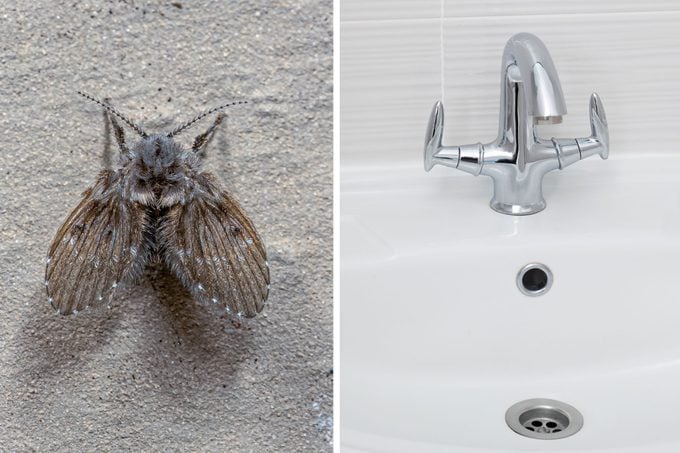How To Get Rid of Small Flies In Your Bathroom
Updated: Apr. 14, 2024
How can something so tiny be so aggravating? Here's what to do if you have drain flies floating about in your home.

When I first noticed the tiny black dots floating in the air near my sink, I thought they were fruit flies. Working off that assumption, I tossed out all the bananas and put the apples in the fridge. But the mass of tiny black flying dots only increased. And that’s when I first learned about drain flies.
These minuscule little beasts are too tiny for us to notice their buzz. Instead, they float about, tangling themselves up in your eyelashes and nostrils. They tend to congregate near sinks, toilets, floor drains, and tubs.
“Regardless of how clean you are, everything that goes down the drain coats it with organic material,” says Eric Braun, an entomologist with Terminix. “Small flies are attracted to this odorous, decaying matter, so that biofilm building up in your drain makes for the perfect breeding ground for drain fly larvae.”
Once established, drain flies can reproduce quickly, so it’s good to try to get a jump on them when you first see them. Here’s what to know about drain flies and how to get them out of your home.
On This Page
About the Experts
- Jonathan Larson is an entomologist, assistant professor and extension professional at the University of Kentucky. He provides insect expertise for household and urban landscape insect issues.
- Eric Braun is a board-certified entomologist who has been a technical service manager for Terminix for nearly three decades.
- Tonya Harris is an award-winning environmental toxin expert, the founder of Slightly Greener and author of The Slightly Greener Method, which offers busy moms simple solutions to reduce toxins. She holds a master’s degree in holistic nutrition, multiple certificates in the environmental health field, and has been featured on numerous national TV shows.
What Are Drain Flies?
Drain flies are small flies that live in drains, pipes and stagnant water. Their larvae (maggots) feed on the slimy growth in these habitats. “They are sometimes called moth flies, as they have wings with scale coverings and slightly fuzzy antennae, granting them a somewhat moth-like appearance,” says Larson. “If you squish them, you might notice the gray scales from their wings on your hand or whatever you used.”
The flies’ larvae are difficult to spot inside the drain, but if you start seeing small flies around your home — commonly in bathrooms and kitchens — chances are you have them.
“To test for [drain flies], place a piece of tape over the drain near to where you’re seeing the small insects,” says Harris. “Drain flies will get caught on the tape as they’re trying to leave the drain, so you will be able to see if you have drain flies in that drain.”
Are Drain Flies Harmful?
Drain flies are not really harmful. It is possible for any fly to transmit disease by transferring pathogens from object to object, but Larson says, “Drain flies are not harmful, some might even argue they are beneficial decomposers that are technically helping to clean the pipes in your home.”
What Causes Drain Flies in the Bathroom?
Drain flies often start in drains that are used infrequently, like a guest bathroom or basement sink. “This allows for a breeding ground to develop,” says Larson. “So the best way to prevent drain flies is to ensure normal use of drains and to prevent leaks or blocked drains.”
Run water through your drains and clean them regularly with brushes and boiling water. In some cases, you may even want to remove and scrub the S trap. Also empty any standing water, like mop buckets and garbage cans.
“Placing a stopper over drains with infrequent use can also help stop drain flies from getting into the drain in the first place,” says Harris.
How To Get Rid of Drain Flies
First, identify which drains are an issue by using the tape method mentioned above. Then “clean, clean, clean,” says Braun. But know that your go-to cleaning chemicals like bleach are no match for these flies. “Most cleaning products will not do anything,” he says. “Don’t focus on the adults; you must remove the breeding area. For every adult fly you kill, there could be many more breeding inside of the drain.
To clean the drain, try these methods:
- Use a long-handled brush with stiff bristles to remove film in the pipe (their food) and destroy maggots and pupae (the life stage between maggots and flies).
- Try a combination of ½ cup salt, ½ cup baking soda and 1 cup vinegar, says Harris. In a large bowl, add the salt first, then the baking soda followed by the vinegar. “Be ready to quickly pour the combination down the drain,” she says. “Once you add the vinegar, it will start to gently bubble and fizz.”
- The next day, pour boiling water down the drain to flush away the remaining residue, larvae and eggs. Repeat this step as necessary.
Larson says that the remaining flies will dissipate once the drain has been cleaned since their breeding ground will have been eliminated.
To get rid of any lingering flies, Harris suggests tightly wrapping the top of a small bowl of apple cider vinegar with plastic wrap. Poke small holes in the plastic so the flies can work their way in, and leave it near the drain. “They will be attracted to the sweetness of the apple cider vinegar and will crawl into the bowl, but it will be difficult for them to get back out,” she says.
